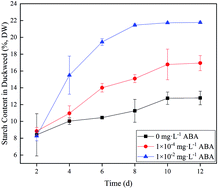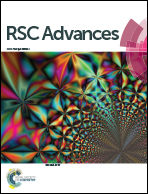Abscisic acid-enhanced starch accumulation of bioenergy crop duckweed (Spirodela polyrrhiza)†
Abstract
To meet the increasing energy consumption around the world and fight global climate change, there is an urgent need to explore renewable energy crops to replace the traditional energy sources. Duckweed (Spirodela polyrrhiza) is widely distributed in the world and has high starch and low lignin contents, which is perhaps an ideal feedstock for bioenergy production. To investigate the effects of abscisic acid (ABA) on duckweed biomass and starch accumulation, Spirodela polyrrhiza was cultivated at different ABA concentrations. The results showed that the highest starch content in duckweed (21.8% dry weight) was achieved in 1.0 × 10−2 mg L−1 ABA medium, 70.3% higher than that of the control medium without ABA. The number of starch granules in 1.0 × 10−2 mg L−1 ABA medium was far more than that in the control medium. The highest adenosine diphosphate (ADP)-glucose pyrophosphorylase (AGPase) activity was observed in the 1.0 × 10−2 mg L−1 ABA medium, which was caused by the up-regulation expression of ADP-glucose pyrophosphorylase 2 (APL2). Further investigations on cell ultra-structures and stomatal property of the duckweed indicated that ABA increased the number and size of starch granules and stomatal size in duckweed cells. These enhancements lead to a greatly improved energy flow in the aquatic plant from photosynthesis to carbon storage, making duckweed a potential renewable bioenergy crop.



 Please wait while we load your content...
Please wait while we load your content...